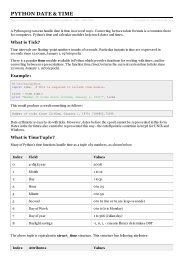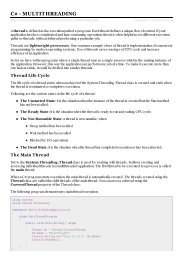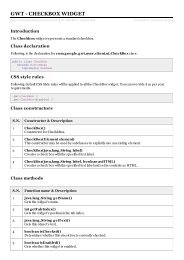Tutorials Point, Simply Easy Learning
Tutorials Point, Simply Easy Learning
Tutorials Point, Simply Easy Learning
You also want an ePaper? Increase the reach of your titles
YUMPU automatically turns print PDFs into web optimized ePapers that Google loves.
30 | P a g e<br />
<strong>Tutorials</strong> <strong>Point</strong>, <strong>Simply</strong> <strong>Easy</strong> <strong>Learning</strong><br />
UML Interaction Diagram<br />
From the name Interaction it is clear that the diagram is used to describe some type of<br />
interactions among the different elements in the model. So this interaction is a part of dynamic<br />
behaviour of the system.<br />
This interactive behaviour is represented in UML by two diagrams known as Sequence diagram<br />
and Collaboration diagram. The basic purposes of both the diagrams are similar.<br />
Sequence diagram emphasizes on time sequence of messages and collaboration diagram<br />
emphasizes on the structural organization of the objects that send and receive messages.<br />
Purpose:<br />
The purposes of interaction diagrams are to visualize the interactive behaviour of the system.<br />
Now visualizing interaction is a difficult task. So the solution is to use different types of models<br />
to capture the different aspects of the interaction.<br />
That is why sequence and collaboration diagrams are used to capture dynamic nature but from<br />
a different angle.<br />
So the purposes of interaction diagram can be describes as:<br />
� To capture dynamic behaviour of a system.<br />
� To describe the message flow in the system.<br />
� To describe structural organization of the objects.<br />
� To describe interaction among objects.<br />
How to draw Interaction Diagram?<br />
As we have already discussed that the purpose of interaction diagrams are to capture the<br />
dynamic aspect of a system. So to capture the dynamic aspect we need to understand what a<br />
dynamic aspect is and how it is visualized. Dynamic aspect can be defined as the snap shot of<br />
the running system at a particular moment.

















